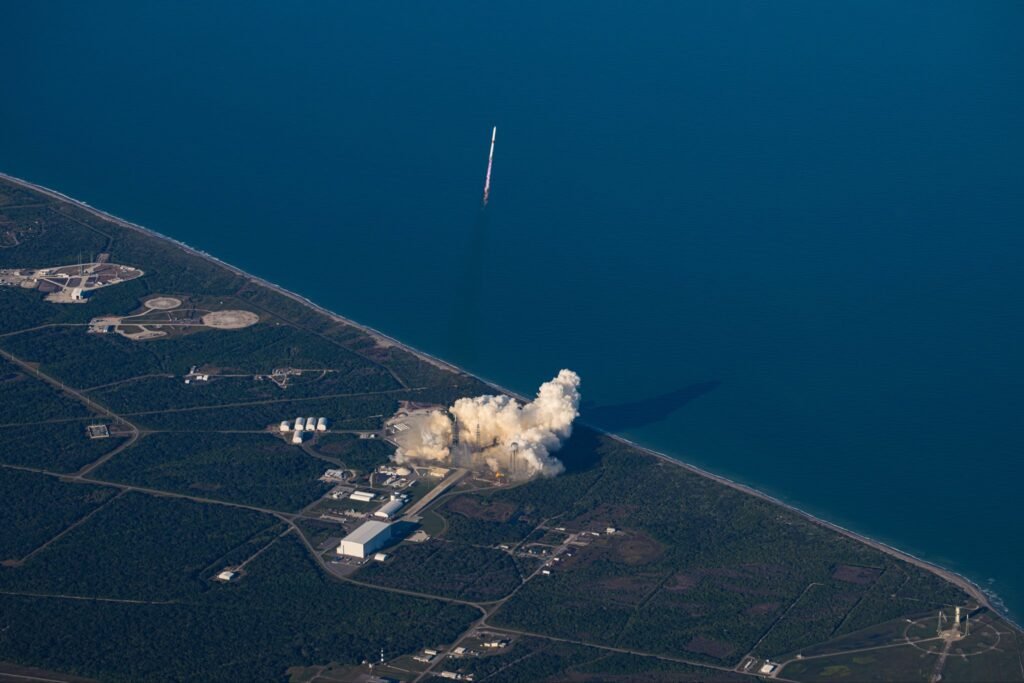What Happened? (The 5 Ws0)
On November 13, 2025, Blue Origin made history at Cape Canaveral with the first successful New Glenn booster landing during a high-profile Mars launch. The rocket carried NASA’s dual ESCAPADE Mars probes and delivered them toward interplanetary orbit, marking a breakthrough in reusable orbital booster technology and Mars exploration. Blue Origin’s achievement elevates it as a premier commercial launch provider and sets the stage for a new era of Martian science missions.
Blue Origin New Glenn Booster Landing: Why It Matters
- Reusable orbital booster: New Glenn’s 188-foot first stage landed softly on Blue Origin’s “Jacklyn” drone ship, confirming reusability at orbital-class scale.
- Second in history: Only SpaceX previously achieved such a milestone, making Blue Origin’s feat newsworthy for the global space industry.
- Lower launch costs: Rapid reusability aims to cut per-mission expenses and enable more frequent Mars missions, aligning with NASA’s and commercial needs.
- Launch site: The rocket launched from Cape Canaveral Space Force Station, a hub for U.S. space milestones.
ESCAPADE Mars Mission Explained
- Mission goal: NASA’s ESCAPADE (Escape and Plasma Acceleration and Dynamics Explorers) consists of two twin probes designed to study the Mars atmosphere, focusing on how solar wind strips molecules from the red planet.
- Why relevant: Understanding Mars’ atmosphere helps scientists plan future human exploration and unravels key mysteries about planetary evolution.
- Timeline:
- Launch: November 13, 2025
- Expected Mars arrival: September 2027
- Spacecraft design: The probes are built by Rocket Lab and UC Berkeley’s Space Sciences Lab.
Blue Origin Rocket Launch: Key Details
- BE-4 engines: The launch was powered by seven BE-4 engines delivering 3.8 million pounds of thrust, showcasing New Glenn’s heavy-lift capacity.
- Payload: NASA’s dual ESCAPADE Mars probes, with advanced plasma and magnetic field analyzers.
- Flight highlights:
- 33 minutes to orbit insertion
- Controlled booster landing 9 minutes after liftoff
“This is just the beginning as we rapidly scale our flight cadence and continue delivering for our customers.”
Dave Limp, Blue Origin CEO
New Glenn vs SpaceX: What This Means
- Market competition: New Glenn challenges SpaceX Falcon Heavy as the only other vehicle with large-scale booster reusability.
- Economics: Commercial payloads, government contracts, and NASA science missions will benefit from decreased cost and increased launch options.
- Future missions: New Glenn is now certified for future Artemis (lunar) support, Amazon’s Project Kuiper satellite launches, and more Mars-bound payloads.
Mars Science: Why ESCAPADE Matters
- Atmospheric loss at Mars is one of planetary science’s biggest puzzles
- ESCAPADE will:
- Track solar wind interaction with Mars’ magnetosphere
- Measure atmospheric escape processes
- Provide crucial data for future manned Mars missions
NASA’s acting administrator Sean Duffy underlined, “ESCAPADE’s results will help pave the way for safer and more sustainable human missions to Mars.”
Authority References
Quick Facts/Bullet Points
- Second only to SpaceX in landing an orbital-class booster
- Blue Origin’s New Glenn is designed for up to 25 flights per booster
- ESCAPADE’s journey to Mars will take 22 months, arriving late 2027
- Cape Canaveral is the launch base for both NASA and commercial space missions
- Each ESCAPADE probe weighs about 125 kilograms
FAQ: Blue Origin New Glenn Mars Mission
Why is New Glenn’s successful booster landing historic?
It’s the first time Blue Origin landed a large orbital-class reusable booster during a Mars science mission, significantly advancing affordable deep-space launches.
What is NASA’s ESCAPADE Mars mission?
It’s a dual-probe mission to study the Martian atmosphere, solar wind, and plasma dynamics, aiming to explain why Mars lost its water and habitability.
How will these successes impact future Mars missions?
They will lower costs, boost frequency, improve science return, and enable reliable supply lines for future robotic and manned Mars exploration.
How does New Glenn compare to SpaceX rockets?
Both are heavy-lift, partially reusable rockets. New Glenn’s successful flight positions Blue Origin as a powerful rival in crewed and deep-space science launches.
Outbound Links (Authority)
- NASA ESCAPADE: science.nasa.gov/mission/escapade
- Blue Origin New Glenn: blueorigin.com/new-glenn/
- Rocket Lab ESCAPADE: rocketlabusa.com/missions/escapade


